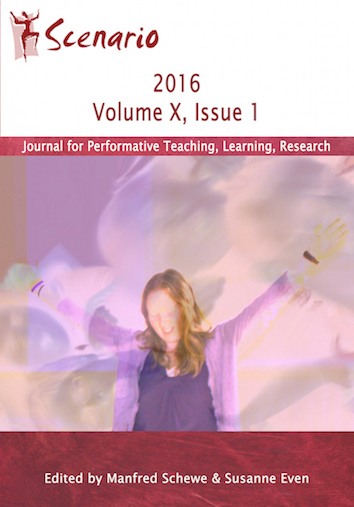Creative English: balancing creative and functional language needs for adult refugees, asylum seekers and migrants
DOI:
https://doi.org/10.33178/scenario.10.1.1Abstract
This article argues that play and creativity are cornerstones of a person-centred approach to adult second language education. However, when learners are refugees, asylum seekers or migrants already living in the country where the language is spoken, it is important that language learning also addresses their functional needs. Creative English is an applied theatre programme for adults in the UK that balances these functional and creative needs while developing confidence in English language communication skills. Drawing on participant-led, practice-based research which resulted in the development of Creative English, this article purports the benefits of an approach that combines playful emotional engagement with pragmatic subject matter. Creative English is based on improvisation. It reduces inhibitions and creates a state highly conducive to learning and taking the risk to communicate in a second language. It also offers the opportunity to rehearse language in everyday life situations. When learners’ perceived needs are met, Maslow’s hierarchy of needs can then be inverted, as creativity allows opportunity to address needs in terms of self-esteem and belonging.Literaturhinweise
Atfield, Gaby; Brahmbhatt, Kavita & O'Toole, Therese (2007): Refugees Experiences of Integration. London: Refugee Council
Blatner, Adam & Blatner, Allee (1988): The Art of Play: An adult's guide to reclaiming imagination and spontaneity. New York: Human Sciences Press
Bonwell, Charles C. & Eison, James A. (1991): Active Learning: Creating Excitement in the Classroom. ASHE-ERIC Higher Education Report No. 1, Washington, DC: George Washington University
Bravo, Maria Da Coceiҫao Condinho (2008): Putting the Reader in the Picture: Screen Translation and Foreign Language Learning. Universitat Rovira I Virgili, Spain. www.teisienxarxa.net/TESIS_URV/AVAILABLE/TDX-0123109-134524/Condhino.pdf [last accessed October 4, 2010]
Brown, Stuart (2009): Play: How it Shapes the Brain, Opens the Imagination and Invigorates the Soul. New York: Penguin Group
Cohen, David (2006): The Development of Play. Hove, East Sussex: Routledge
Doddington, Christine & Hilton, Mary (2007): Child-Centred Education: Reviving the Creative Tradition. London: Sage
Dodson, Sarah L. (2002) The Educational Potential of Drama in ESL. In: Bräuer, Gerd (ed.): Body and Language. Westport: Ablex Publishing, 161-178
Duffy, Bobby & Frere-Smith, Tom (2014): Perceptions and Reality: Public Attitudes to Immigration. London: Ipsos MORI Social Research Institute
Entwistle, Harold (2012): Child-Centred Education. Abingdon, Oxon: Routledge
ESOL Inquiry Executive Summary (2006): NIACE. www.niace.org.uk/projects/esol-enquiry/documents/ESOL-Inquiry-ExecutiveSummary.pdf [last accessed May 20, 2007]
Fleming, Mike (1998): Cultural Awareness and Dramatic Art Forms. In: Byram, Michael & Fleming, Mike (eds.): Language Learning in Intercultural Perspective. Cambridge: Cambridge University Press, 147-157
Furukawa, Emi & Hunt, Dennis J. (2011): Therapy with Refugees and Other Immigrants Experiencing Shame: A Multicultural Approach. In: Dearing, Ronda D. & Tangney, June Price (eds.): Shame in the Therapy Hour. Washington: American Psychological Association 195-215
Garza, Thomas (1991): Evaluating the Use of Captioned Video Materials in Advanced Foreign Language Learning. In: Foreign Language Annals 24, 239-258
Hicks, David (n.d.): Person-centred Education. In Education and Ideology. n.d. www.teachingforabetterworld.co.uk/docs/Person-centred_Education.pdf [last accessed June 20, 2013]
Kao, Shin-Mei & O'Neill, Cecily (1998): Words into Worlds. London: Ablex Publishing
Kesete, Nisan; Thom, Danielle & Harvey, Heather (2015): Settling in. In: Experiences of Women on Spousal Visas in the UK. London: Eaves
Krashen, Stephen D. & Terrell, Tracy D. (1983): The Natural Approach: Language Acquisition in the Classroom. Oxford: Pergamon Press
Krashen, Stephen (2003): Explorations in Language Acquisition and Use. Portsmouth: Heinemann
Long, Michael (1991) Focus on form: A design feature in language teaching methodology. In: De Bot, Kees; Ginsberg, Ralph & Kramsch, Claire (eds.) Foreign Language Research in Cross-cultural Perspective. Amsterdam: John Benjamins 39-52
Long, Michael (1996): The role of the linguistic environment in second language acquisition. In: Ritchie, William & Bhatia, Tej (eds.): Handbook of Second Language Acquisition. San Diego, CA: Academic Press 413-468
Maslow, Abraham H. (2011): Toward a Psychology of Being. Blacksburg, VA: Wilder Publications
Maslow, Abraham H. (1987): Motivation and Personality. New York: Harper and Row
Maslow, Abraham H. (1971): The Farther Reaches of Human Nature. New York: The Viking Press
Moore, Kerry; Gross, Bernhard & Threadgold, Terry (eds.) (2012): Migrations and the Media. Oxford: Peter Lang Ltd
Moore, Kerry; Mason, Paul & Lewis, Justin (2008): Images of Islam in the UK: The Representation of British Muslims in National Print News Media 2000-2008. Cardiff: Cardiff School of Journalism, Media and Cultural Studies
Palmer, David & Ward, Kim (2006): Unheard Voices: Listening to Refugees and Asylum Seekers in the Planning and Delivery of Mental Health Service Provision in London. London: Commission for Patient and Public Involvement in Health
Panayi, Panikos (1999): The Impact of Immigration. Manchester: Manchester University Press
Panksepp, Jaak (1998): Affective Neuroscience: the foundations of human and animal emotions. Oxford: Oxford University Press
Piazzoli, Erika (2011): Process drama: the use of affective space to reduce language anxiety in the additional language learning classroom. In: Research in Drama Education 16, 557-573
Sanderson, Helen (2000): Person-centred Planning: Key Features and Approaches. Joseph Rowntree Foundation. www.familiesleadingplanning.co.uk/documenst/pcp%20features%20&%20styles.pdf [last accessed June 20, 2013]
Swain, Merrill (2000) The output hypothesis and beyond: Mediating acquisition through collaborative dialogue. In: Lantolf, James P.: Sociocultural Theory and Second Language Learning. Oxford: Oxford University Press, 97-114
Tassoni, Penny & Beith, Kate (2002): Child Care and Education. Oxford: Heinemann
Thompson, James (2009) Performance Affects: Applied Theatre and the End of Effect. Basingstoke: Palgrave Macmillan
Tidyman, Mary; Gale, Elizabeth & Seymour, Linda (2004): Celebrating Our Cultures: Guidelines for Mental Health Promotion with Black and Minority Ethnic Communities. London: Department of Health
Turner, Victor (1982): From Ritual to Theatre: The Human Seriousness of Play. New York: PAJ Publications
Verinder, Ben (2011): Association of Colleges ESOL Survey. In: Association of Colleges. www.aoc.co.uk/briefings/AoC_ESOL_Survey_ February_2011.pdf [last accessed July 29, 2013]
Downloads
Veröffentlicht
Ausgabe
Rubrik
Lizenz
Copyright (c) 2016 the author(s)

Dieses Werk steht unter der Lizenz Creative Commons Namensnennung - Nicht-kommerziell - Keine Bearbeitungen 4.0 International.







